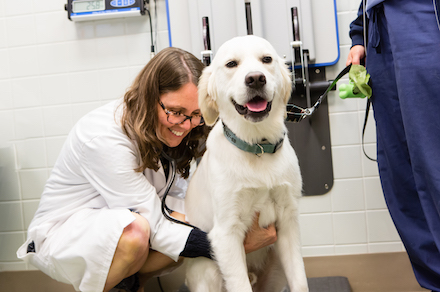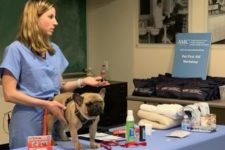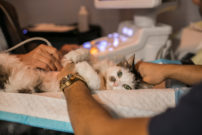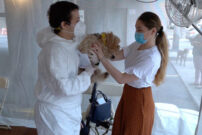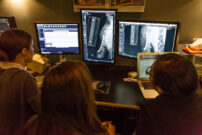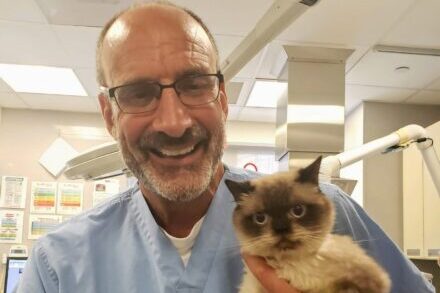THR, DPO, FHO, TPLO and TTA: How to Talk to Your Veterinarian About Orthopedic Surgery

THR, DPO, FHO, TPLO and TTA: How to Talk to Your Veterinarian About Orthopedic Surgery
AMC’s board-certified veterinary surgeons frequently repair the hips and knees of dogs and cats. Multiple procedures exist to correct torn ligaments, dislocated hips and improve a dog’s ability to walk when hip dysplasia is severe. In the language of veterinary medicine, each of these procedures has an acronym that veterinarians use when talking about the procedure. Today’s blog post describes these procedures and their acronyms.
Total Hip Replacement and Pelvic Osteotomy
Hip dysplasia is one of the most common joint diseases in dogs. It is a skeletal condition where the ball-and-socket of the hip joint doesn’t align properly, causing excess wear on the surrounding tissue as well as weakness and pain. Total hip replacement or THR improves joint function by recreating the joint with a prosthesis. In the x-ray above, you see a dog with a THR on the right hip and the untreated dysplastic hip on the left. The link to the video shows a happy and very mobile dog who has recovered from a THR performed at AMC.
Pelvic osteotomy is another, though less common, procedure to treat hip dysplasia. There are two versions of the pelvic osteotomy: a double (DPO) and triple (TPO). An “osteotomy” refers to a surgery where one or more bones are cut. In the case of DPO and TPO, the pelvic bones are cut and repositioned using plates and screws to situate the ball more deeply in the hip socket, improving joint function. DPO or TPO is the preferred hip dysplasia treatment in young dogs, but many dogs are not diagnosed with hip dysplasia until they are older, which is why this procedure is less common.
Femoral Head and Neck Ostectomy
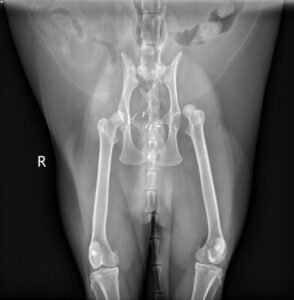
Femoral head and neck ostectomy, or FHO, is an alternative procedure to manage hip dysplasia or a dislocated hip in cats or small dogs with an ideal body condition score. The x-ray at the right shows a cat with a hip luxation, a condition where the ball has come completely out of the hip socket. Instead of trying to recreate or reposition the ball into the socket, as in THR and DPO/TPO respectively, FHO removes the ball part of the joint entirely. This removes the source of pain for the animal. Initially, the hip muscles support the joint after surgery until scar tissue forms a “false joint” which allows normal ambulation. The false joint is not strong enough to support large breed dogs, which is why a THR is the preferred treatment for large dogs.
Tibial Plateau Leveling Osteotomy and Tibial Tuberosity Advancement
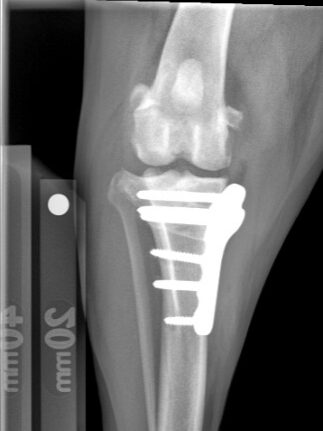
Cranial cruciate ligament (CCL) tears are common in dogs. While CCL tears can happen in all dogs, some breeds are predisposed to cranial cruciate ligament disease (CCLD), including Rottweilers, St. Bernards, Newfoundlands, German shepherd dogs and other large breed dogs. CCL tears are similar to ACL tears in humans, however in dogs the cause is not trauma but a slow degeneration of the fibers comprising the cruciate ligament.
There are many techniques to repair torn canine cruciate ligaments, including tibial plateau leveling osteotomy (TPLO) and tibial tuberosity advancement (TTA). Currently, TPLO is preferred over tibial TTA, based on recent research. For this reason, TPLO is the procedure favored by AMC surgeons and is shown in the x-ray on the right.
Now that you have orthopedic surgery lingo mastered, be sure to bone up on the many kidney disease acronyms your veterinarian may use in a prior blog post – CKD, BUN, USG, and AKI: How to Talk to Your Pet’s Veterinarian About Kidney Disease.





